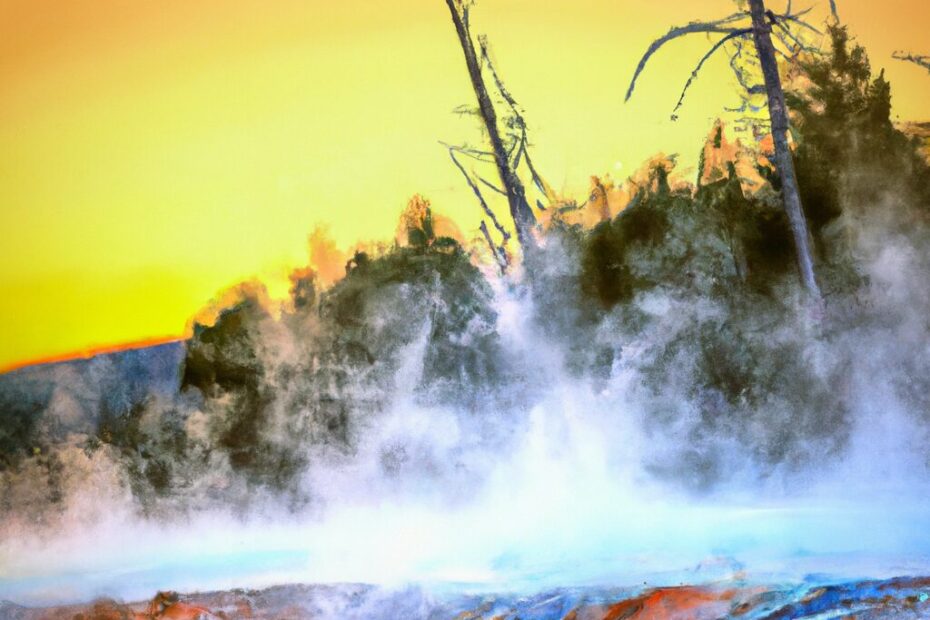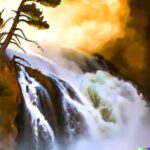If you’re a photography enthusiast planning a trip to Yellowstone National Park, you won’t want to miss the opportunity to capture the stunning beauty of the park’s geysers.
In this article, we’ll explore what geysers are and how they work, where to find them in Yellowstone, and the best time to photograph them. We’ll also provide tips on the equipment you’ll need, the best camera settings to use, and how to capture unique and captivating photos while staying safe.
So, grab your camera and get ready to learn all about Yellowstone geysers photography!
What Are Geysers?
Geysers are natural hydrothermal features that periodically erupt hot water and steam, often accompanied by impressive displays of natural beauty and dramatic scenery. These geothermal marvels form when underground water is heated by molten rock, creating pressure that forces the superheated water and steam to erupt through vents in the Earth’s crust.
Located in Yellowstone National Park, these captivating thermal phenomena offer a unique sensory experience, combining the force of nature with awe-inspiring visual and auditory effects. The park is home to a high concentration of geysers, including the famous Old Faithful, making it a must-see attraction for visitors.
How Do Geysers Work?
The operation of geysers involves the interaction of underground water reservoirs with geothermal heat, resulting in periodic eruptions of hot water and steam, creating captivating displays of natural phenomena and scenic beauty within sites like Yellowstone National Park.
This mesmerizing process begins with precipitation seeping into the ground, where it penetrates deeply and encounters areas heated by the Earth’s core. As the water delves into the earth, it is gradually heated, forming a reservoir. The intense heat causes the water to expand, creating immense pressure. Eventually, this pressure forces the scorching water upwards through narrow fissures, culminating in the awe-inspiring eruptions that we witness at geyser basins like those in Yellowstone.
Where Can You Find Geysers in Yellowstone?
Yellowstone National Park is renowned for its abundant geothermal wonders, including an array of captivating geysers scattered throughout the park’s diverse landscape. This offers visitors picturesque landscapes and unique natural beauty.
Yellowstone National Park is home to some of the most iconic geysers in the world, including Old Faithful and Grand Prismatic Spring. These natural wonders play a vital role in the park’s environment, providing a stunning contrast against the rugged landscape. As visitors explore the geyser basins, they are immersed in a surreal and captivating experience, surrounded by bubbling hot springs and vibrant microbial mats that showcase the park’s diverse thermal features.
But the significance of these geysers goes beyond their beauty. They also have a symbiotic relationship with the park’s flora and fauna, highlighting their crucial role in the park’s ecosystem. So when you visit Yellowstone, make sure to take some time to marvel at these incredible geysers and appreciate their importance in this unique natural environment.
When Is the Best Time to Photograph Geysers in Yellowstone?
The ideal time to capture stunning geyser photographs in Yellowstone is influenced by environmental factors such as lighting, weather conditions, and the natural phenomena associated with geyser eruptions, ensuring the best opportunities for capturing the park’s picturesque landscapes and scenic beauty.
During the early morning or late afternoon, the soft, warm light enhances the vibrant colors of the geysers and creates a captivating contrast with the surrounding natural elements.
Weather conditions, particularly during the spring and early summer, offer clearer skies and the potential for dramatic cloud formations, adding depth and character to the photographs. The visual impact of geyser eruptions, with their soaring columns of steam and water, can be maximized by choosing vantage points that showcase the dynamic and awe-inspiring nature of these natural phenomena.
What Equipment Do You Need for Geyser Photography?
Capturing the essence of geysers through photography requires essential equipment such as a high-quality camera, versatile lenses, a sturdy tripod, and other gear tailored for outdoor photography.
This ensures the ability to seize the unique formations and dramatic scenery of geyser eruptions.
The high-quality camera allows for capturing intricate details, while the versatile lenses enable diverse compositions and perspectives, essential for showcasing the magnificence of the eruptions.
A sturdy tripod becomes indispensable for stability, especially in the outdoor elements, ensuring sharp and crisp images.
Outdoor-specific gear like protective covers and weather-resistant equipment safeguard the photography gear from the challenging and ever-changing conditions of geyser landscapes.
Camera
A high-quality camera with adjustable settings and a robust build is crucial for geyser photography. This enables professional photographers and outdoor enthusiasts to capture the captivating thermal features and scenic landscapes with precision and clarity.
The camera’s ability to adjust settings such as exposure, aperture, and shutter speed is essential for capturing the varying light conditions around geysers. This allows for optimal image quality and ensures that each shot is perfectly exposed.
A durable build is also important for a camera used in geyser photography. It must be able to withstand the rugged outdoor environments often associated with this type of photography, ensuring that it can keep up with the demands of the environment.
The image quality delivered by such cameras is paramount. It ensures that the intricate details and colors of the thermal features are faithfully reproduced, providing stunning visuals for photographers and enthusiasts alike. With a high-quality camera, you can capture the true beauty of geysers and showcase it to the world.
Lenses
Versatile lenses play a critical role in geyser photography, facilitating the capturing of dynamic compositions, dramatic scenery, and unique formations. These lenses are essential for capturing the fast-paced, unpredictable nature of geyser eruptions.
They allow photographers to freeze the moment when scalding water and steam erupt from the Earth’s surface. Their ability to adjust focal length and aperture settings aids in bringing out the stunning details of the bubbling water and the surrounding landscape. This creates visually impactful images that convey the raw power and beauty of these natural wonders.
Tripod
A sturdy tripod is an indispensable tool for geyser photography, providing stability and enabling long exposure shots that reveal the intricate details and natural wonders of geyser eruptions, ensuring the preservation of stunning vistas and environmental factors.
Photographers rely on tripods to capture the dynamic and unpredictable nature of geyser eruptions without the risk of camera shake. This allows for crystal-clear images of the awe-inspiring displays of natural beauty.
By anchoring the camera securely, tripods also enable photographers to experiment with different exposure settings. This results in capturing the ethereal beauty of geyser eruptions while preserving the integrity of the natural environment. Their role in maintaining the authenticity and raw beauty of these natural phenomena cannot be overstated.
Filters
Utilizing filters can enhance the scenic beauty and visual impact of geyser photography, enriching the outdoor photographic experience and ensuring the optimal portrayal of the captivating landscapes and thermal features associated with geyser eruptions.
Photographers can capture the vivid colors and intricate details of geyser eruptions with the help of filters. These filters also aid in controlling light and reducing glare, resulting in sharper images with accurate color reproduction. This allows for the raw beauty of nature to be showcased in all its glory.
Polarizing filters are especially useful for enhancing the reflection of thermal features on water surfaces, creating mesmerizing compositions and enriching the overall visual appeal of geyser photography.
What Are the Best Settings for Geyser Photography?
Optimizing the aperture, shutter speed, and ISO settings of your camera is essential for geyser photography, enabling photographers to capture the dynamic nature and visual allure of geyser eruptions with precision and artistic finesse.
These settings play a crucial role in freezing the fast-moving water droplets and steam, ensuring that every detail of the eruption is captured flawlessly.
By adjusting the aperture, photographers can control the depth of field, creating stunning compositions with sharp foregrounds and beautifully blurred backgrounds. Similarly, setting the shutter speed appropriately gives the option to freeze the eruption in action or capture the flowing movement of the water, adding a sense of drama to the images.
Managing the ISO setting helps in balancing the exposure, especially in low-light conditions around geyser sites, ensuring that the images retain clarity and details without excessive noise. Thus, mastering these settings enhances the ability to create captivating and powerful geyser photographs that vividly illustrate the natural beauty and energy of these remarkable phenomena.
Aperture
Adjusting the aperture settings is crucial in geyser photography. It directly impacts lighting, composition, and the portrayal of stunning vistas. This allows photographers to convey the dramatic scenery and natural beauty of geyser eruptions.
By adjusting the aperture, photographers can control the amount of light entering the camera. This results in a more balanced exposure of steam and water droplets during an eruption. It also plays a crucial role in achieving the desired depth of field, adding dimension and scale to the geyser landscape and creating a visually captivating composition.
Skilled manipulation of aperture settings can transform a geyser photo into a captivating visual narrative. It effectively captures the essence of these awe-inspiring natural phenomena. So, don’t underestimate the power of aperture adjustments in geyser photography!
Shutter Speed
The manipulation of shutter speed for long exposure shots is essential in geyser photography. This allows photographers to reveal the intricate details and dynamic nature of the natural phenomena associated with geyser eruptions, preserving captivating visual experiences.
With this technique, photographers can capture the graceful arc of water as it emerges from the earth. The fluid movement is frozen into a mesmerizing display of fluidity.
By adjusting the shutter speed, photographers can accentuate the power and force of the eruption or create a soft, ethereal effect. This brings out the natural beauty of the geyser’s eruption.
The skillful use of shutter speed in geyser photography can truly transport viewers to the awe-inspiring spectacle of nature’s raw energy.
ISO
Adjusting the ISO settings is crucial for geyser photography, as it affects the exposure of images and can influence the portrayal of environmental impact. This ensures the optimal capture of the captivating landscapes and thermal features associated with geyser eruptions.
The ISO adjustments play a significant role in balancing the exposure to capture the dynamic and high-contrast scenes near geysers.
By fine-tuning the ISO setting, photographers can control the amount of light reaching the camera sensor. This enables them to maintain image quality while adjusting to the changing environmental conditions.
This adaptability allows for stunning visual storytelling that not only showcases the natural beauty, but also highlights the fragility and impact of geological phenomena on the surrounding ecosystem.
How Can You Capture Unique Photos of Geysers?
Capturing unique photographs of geysers involves exploring different angles, incorporating people or wildlife to add depth and narrative, and experimenting with long exposure techniques, allowing photographers to seize the distinctive formations and captivating visual narratives of geyser eruptions.
This exploration can lead to discovering mesmerizing vantage points, such as from behind cascading water or through surrounding vegetation, enabling a more intimate and immersive portrayal of the geyser’s energy.
The inclusion of people or wildlife amidst the geyser’s eruption can offer a sense of scale and emotion, adding layers of storytelling to the images. Long exposure techniques can further enhance the drama and dynamism of geyser eruptions, capturing the full spectrum of movement and intensity in a single frame.
Use Different Angles
Exploring different angles is pivotal in geyser photography, as it allows photographers to capture diverse compositions and convey the grandeur of natural wonders through distinct visual perspectives, enriching the portrayal of geyser eruptions.
By adjusting the shooting angle, photographers can reveal the intricate details of the geyser’s eruption, emphasizing the interplay of light and water dynamics. Varied angles also enable the inclusion of intriguing foreground elements, such as surrounding vegetation or rock formations, creating a captivating juxtaposition of natural elements.
Experimenting with different angles encourages the exploration of the geyser’s surroundings, unveiling unique vantage points that emphasize the scale and power of the eruption. This multifaceted approach to composition elevates the visual narrative of geyser photography, inviting viewers to immerse themselves in the awe-inspiring displays of natural phenomena.
Incorporate People or Wildlife
Incorporating people or wildlife into geyser photography adds depth and narrative to the visual story, creating captivating scenes and enriching the outdoor experience with the presence of wildlife such as bison, elk, and birds amidst the dynamic thermal features.
The juxtaposition of human or animal figures against the dramatic backdrop of erupting geysers or bubbling hot springs not only adds a sense of scale and perspective to the images but also infuses them with a sense of action and life.
The dynamic interplay between the human or wildlife subjects and the natural thermal features brings a unique blend of adventure and serenity to the photographs, capturing the essence of wild and untamed landscapes. This synergy fosters an immersive narrative, elevating the visual impact and enhancing the storytelling aspect of geyser photography.
Experiment with Long Exposures
Experimenting with long exposure techniques in geyser photography allows photographers to convey the dynamic nature and dramatic scenery of eruptions, enabling the capture of stunning visuals that encapsulate the essence of geyser phenomena.
This technique enhances the ability to depict the powerful and mesmerizing display of water and steam as they erupt from the earth’s surface.
By lengthening the exposure time, the flowing movement of the water and the billowing clouds of steam can be beautifully captured, creating a sense of both tranquility and energy in the resulting images.
Long exposure photography can emphasize the contrast between the stillness of the surroundings and the vibrant eruption, adding depth and drama to the composition.
What Safety Precautions Should You Take When Photographing Geysers?
When photographing geysers, it is crucial to prioritize safety by adhering to designated pathways, respecting conservation efforts, and contributing to the preservation of these natural wonders, ensuring a responsible and respectful approach towards environmental protection within Yellowstone National Park.
This careful approach not only safeguards visitors and the delicate ecosystems but also sets a positive example for others.
By staying on designated pathways, one can minimize the impact on the fragile geothermal features and habitats, aiding in their long-term conservation.
Being mindful of waste disposal and minimizing one’s footprint can further contribute to the overall preservation of these unique and magnificent natural landscapes.
Frequently Asked Questions
What are some tips for photographing the geysers in Yellowstone National Park?
To get the best photos of Yellowstone geysers, try visiting during early morning or late afternoon for soft lighting and avoid crowds. Also, use a tripod to stabilize your camera and experiment with different angles to capture unique shots.
What camera equipment should I bring for photographing Yellowstone geysers?
Bring a wide-angle lens, as well as a zoom lens for close-up shots. It’s also important to have a sturdy tripod and a remote shutter release to prevent camera shake. Additionally, bring extra batteries and memory cards for longer shoots.
How can I capture the steam and colors of the geysers in my photos?
Adjust your camera’s white balance to “cloudy” or “shade” to enhance the warm tones of the steam and minerals. You can also try using a polarizing filter to reduce glare and make the colors pop.
Are there any safety precautions I should take while photographing geysers in Yellowstone?
Always stay on designated boardwalks and maintain a safe distance from the geysers. The ground can be unstable and the water is extremely hot, so it’s important to follow park regulations to avoid accidents.
Can I photograph geysers in Yellowstone during the winter?
Yes, Yellowstone’s geysers are active year-round. Winter can actually be a great time to capture unique shots with snow-covered landscapes and steam rising from the geysers. Just be sure to dress warmly and protect your camera from the cold.
Are there any photography workshops or tours specifically for Yellowstone geysers?
Yes, there are many photography workshops and tours available in Yellowstone that focus on capturing the beauty of the geysers. These can be a great way to improve your skills and get insider tips from experienced photographers.
Last Updated on January 25, 2024 by Jon Waraas – Originally Posted: January 25, 2024

I’m Jon Waraas, and I’ve been navigating the online world since 2006. By day, I’m the proud owner of some eCommerce gems, and by night, I’m the voice behind the adventures on Waraas.Com.
My heart, however, belongs to the wild beauty of Yellowstone National Park. I’ve got a collection of websites dedicated to sharing the wonders of this natural masterpiece. Oh, and did I mention? I’m currently building my own cabin inside the ghost town of Gilmore, Idaho – a cabin with tales to tell!
When I’m not immersed in the digital realm, you’ll find me lacing up my boots for a good hike or setting up camp under the star-studded sky.




